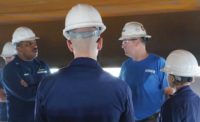The new 400-acre YMCA camp—nestled on the mountainside above Horsethief Reservoir, 10 miles east of Cascade in central Idaho—will offer youngsters a one-of-a-kind outdoor experience.
“We believe camps are a magical place for kids,” says Jim Everett, the Treasure Valley Y’s chief executive officer. “From our zip line and climbing wall that was formed in the shape of Idaho to the inclusive nature of our campers and staff, kids really feel a sense of belonging and acceptance. The pristine location and experience of becoming ‘unplugged’ allows kids to get in touch with nature and to connect in a face-to-face way with each other. It is really a special place.”
After more than seven years of planning and work, the camp at Horsethief had its grand opening in June. “We figure the completed project will come in at $22 million in donations,” says Tim Wilcomb of Jordan-Wilcomb Construction of Boise. “We are at $18 million right now, with planning that began in 2003 and groundbreaking in the summer of 2005. During the summers of 2008 and 2009, we did the primary construction.”
The camp has cabins; yurts; a main lodge; and outdoor, educational and water-sport activities. A temporary, 6,000-sq-ft lodge was finished before the grand opening and serves as the dining facility, shower house and gathering hall. The eventual 18,000-sq-ft main lodge will include a dining hall, 2,000-sq-ft conference room and administrative offices.
Upgrades include 10 cabins and five yurts, each designed to sleep 10 youngsters and two counselors. The cabins each have three windows, providing natural light as well as ventilation for heating and cooling.
Wilcomb says the master plan calls for future camp expansion and that there was a lot of preplanning. “We had to plan for as large a facility as possible on the available land,” Wilcomb adds. “We sized the wastewater or water system for ultimate capacity and put in 4-in. pipe rather than 2-in. pipe.”
Betsy Roberts, project manager for engineering firm’s CH2M Hill’s Boise office, says, “Our focus on the infrastructure was a major challenge because the camp is not connected to any other system, whether its wastewater, power, irrigation, roads or storm drainage.”
Water Witching
Planning began in 2003 with an agreement with Idaho Fish and Game that the camp could use the reservoir as a water source only if no groundwater was found. “We drilled at least four wells and didn’t get much because we are sitting on the Idaho Batholith,” Roberts says. The Batholith is a mass of granite covering approximately 15,400 sq miles in central Idaho.
Roberts says that after the wells didn’t pan out, planners used the reservoir to fill the camp’s 54,000-gal. potable water storage tank and the 150,000-gal. fire suppression tank once they were located atop the mountain. The fire tank can provide 1,250 gpm for two hours.
Because the surface water needed more treatment than ground water, “we used scuba divers to place piping and an intake structure on the bottom of the reservoir,” Roberts says.
“On the top of the mountain, we had to blast several hundred feet of trenching and we needed to put the water storage tanks in the ground at a depth of about 6 ft.”
The full water-treatment facility pulls water out of the reservoir and treats it using a slow-sand filter and pumps it up about 200 ft above the camp. The entire camp uses gravity flow.
Wilcomb says several governmental agencies with various jurisdictions were involved in camp planning. The infrastructure is all new, “and all the agencies want to make sure things are done correctly,” he says.
Roberts says workers also trenched in the power from 7 miles away instead of going overhead because of safety concerns in case of a forest fire that might knock out power. “Since it was three-phase power, the best thing to do was to put it underground for long-term safety, security and aesthetics,” Roberts says.






Post a comment to this article
Report Abusive Comment